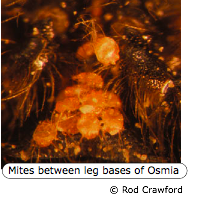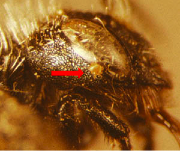
The female mite hitch-hikes [as a hypopus] on a bee to the nest, where it jumps off and makes itself at home in a larval cell. After it matures, it rapidly produces a small number of parthenogenic young that may feed on the bee egg or larva, usually killing it. These mites then reproduce, some sexually, and begin to feed on the bee hosts' pollen ball. The population grows explosively, and within a few months can turn the bee food into a solid writhing mass of mites. You may open a BOB nest and find such a mass any time from midsummer through the following spring. In the mass are various developmental stages and both sexes, although mostly females. The female has two pink sclerites on her dorsum, which gives groups of the adult mites a pinkish tinge. She also has two long setae on the hind tarsus, whence the common name.

Those of you who keep or observe blue orchard bees (BOBs a.k.a. orchard mason bees, Osmia lignaria) may have noticed a brown scunge on your bees this year. Some bees may be unable to fly, and fall to the ground to become ant food in an untimely way. These bees are infested with Krombein's hairy-footed mite, Chaetodactylus krombeini(Chaetodactylidae), a native parasite and phoretic "hitchhiker" of cavity nesting bees in the family Megachilidae (leafcutting bees, mason bees, etc.). Populations of this mite have been building for several years in managed and semi-managed populations of BOBs, but they also appear to be infesting wild bees. (This mite is entirely different from the mites now decimating honey bees.)
© Rod Crawford
This article originally appeared in Scarabogram, May 2000, New Series No. 241, pp. 2-3.

